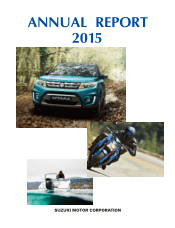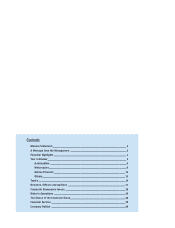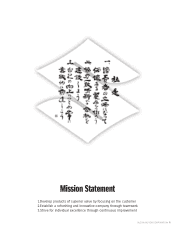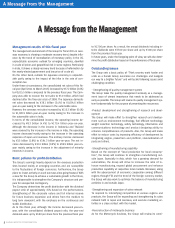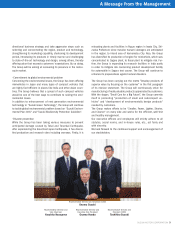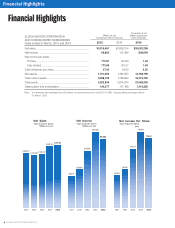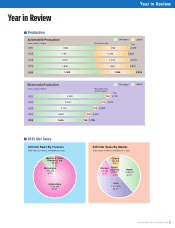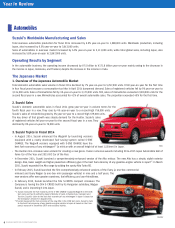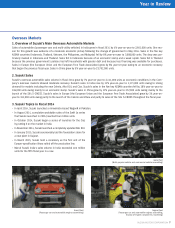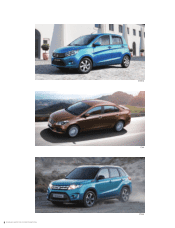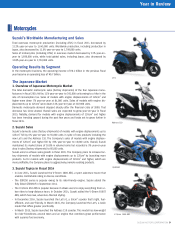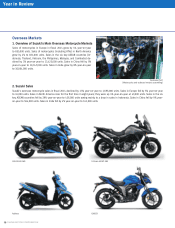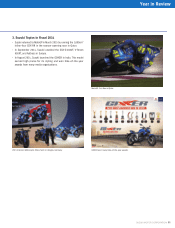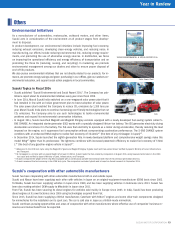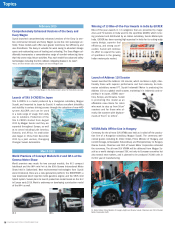Suzuki 2015 Annual Report Download - page 8
Download and view the complete annual report
Please find page 8 of the 2015 Suzuki annual report below. You can navigate through the pages in the report by either clicking on the pages listed below, or by using the keyword search tool below to find specific information within the annual report.
6 SUZUKI MOTOR CORPORATION
Year in Review
Automobiles
Suzuki’s Worldwide Manufacturing and Sales
Total overseas automobile production for scal 2014 increased by 6.9% year-on-year to 1,988,000 units. Worldwide production, including
Japan, also increased by 6.5% year-on-year to 3,043,000 units.
Sales of automobiles in overseas market increased by 6.6% year-on-year to 2,111,000 units, while total global sales, including Japan, also
increased by 5.8% year-on-year to 2,867,000 units.
Operating Results by Segment
In the automobile business, the operating income decreased by ¥7.5 billion to ¥171.8 billion year-on-year mainly owing to the decrease in
the income in Japan, Indonesia, and Thailand, despite the increase in the income in India.
The Japanese Market
1. Overview of the Japanese Automobile Market
Total domestic automobile sales volume in scal 2014 declined by 7% year-on-year to 5,297,000 units. It fell year-on-year for the rst time
in four scal years because a consumption-tax hike in April 2014 dampened demand. Sales of registered vehicles fell by 9% year-on-year to
3,124,000 units. Sales of minivehicles fell by 4% year-on-year to 2,173,000 units. Still, sales of minivehicles exceeded 2,000,000 units for the
second scal year in a row. Minivehicles accounted for 41% of overall automobile sales. The proportion exceeded 40% for the rst time.
2. Suzuki Sales
Suzuki’s domestic automobile sales in scal 2014 grew year-on-year in volume terms for the
fourth scal year in a row. They rose by 4% year-on-year to a record-high 756,000 units.
Suzuki’s sales of minivehicles grew by 5% year-on-year to a record-high 679,000 units.
The key driver of that growth was steady demand for the Hustler. Suzuki’s sales
of registered vehicles fell year-on-year for the second scal year in a row. They
declined by 6% year-on-year to 76,000 units.
3. Suzuki Topics in Fiscal 2014
• In August 2014, Suzuki enhanced the WagonR by launching versions
equipped with a newly developed fuel-saving system called S-ENE
CHARGE. The WagonR versions equipped with S-ENE CHARGE have the
best fuel economy of any miniwagon*1 (a minicar with an overall height of at least 1,550mm) in Japan.
• The Hustler mini-crossover won acclaim for creating a new genre. It won numerous awards including 2014–2015 Japan Automobile Hall of
Fame Car of the Year and 2015 RJC Car of the Year.
• In December 2014, Suzuki launched a comprehensively enhanced version of the Alto minicar. The new Alto has a simple, stylish exterior
design. Also, lower weight and higher powertrain eciency give it the best fuel economy of any gasoline-engine vehicle in Japan*2. In March
2015, Suzuki expanded the Alto range by adding the sporty Alto Turbo RS.
• In February 2015, Suzuki launched the rst comprehensively enhanced versions of the Every (a one-box commercial
minivan) and Every Wagon (a one-box mini passenger vehicle) in nine and a half years. The
new versions oer even greater roominess, fuel eciency, and user-friendliness.
• In February 2015, Suzuki launched the SX4 S-CROSS compact crossover. The
Company is having the SX4 S-CROSS built by its Hungarian subsidiary, Magyar
Suzuki, and is importing it into Japan.
*1 Suzuki measured the fuel economy of the S-ENE CHARGE-equipped WagonR in the JC08
test cycle and had it veried by Japan’s Ministry of Land, Infrastructure, Transport and
Tourism. Suzuki’s claim to the best fuel economy of any miniwagon in Japan is based on
the Company’s research in August 2014.
*2 Suzuki measured the fuel economy of the new Alto in the JC08 test cycle. Suzuki’s claim
to the best fuel economy of any gasoline-engine vehicle in Japan is based on the Com-
pany’s research in December 2014 and excludes hybrids.
Alto
Hustler

